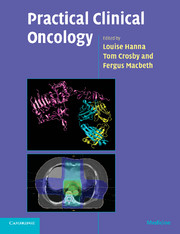Book contents
- Frontmatter
- Contents
- List of contributors
- Preface
- Acknowledgements
- Abbreviations
- 1 Practical issues in cytotoxic chemotherapy usage
- 2 Biological treatments in cancer
- 3 Hormones in cancer
- 4 Radiotherapy planning
- 5 Research in cancer
- 6 Oncological emergencies
- 7 Palliative care
- 8 Head and neck
- 9 Oesophagus
- 10 Stomach
- 11 Liver, gallbladder and biliary tract
- 12 Exocrine pancreas
- 13 Colon and rectum
- 14 Anus
- 15 Gastrointestinal stromal tumours
- 16 Breast
- 17 Kidney
- 18 Bladder
- 19 Prostate
- 20 Testis
- 21 Penis
- 22 Ovary
- 23 Body of the uterus
- 24 Cervix
- 25 Vagina
- 26 Vulva
- 27 Gestational trophoblast tumours
- 28 Lung
- 29 Mesothelioma
- 30 Soft tissue and bone tumours in adults
- 31 The lymphomas and myeloma
- 32 Central nervous system
- 33 Skin cancer other than melanoma
- 34 Melanoma
- 35 Thyroid
- 36 Neuroendocrine tumours
- 37 Cancer in children
- 38 Cancer of unknown primary
- 39 The use of radiotherapy in the treatment of benign conditions
- Multiple choice questions
- Multiple choice answers
- Index
- References
26 - Vulva
Published online by Cambridge University Press: 23 December 2009
- Frontmatter
- Contents
- List of contributors
- Preface
- Acknowledgements
- Abbreviations
- 1 Practical issues in cytotoxic chemotherapy usage
- 2 Biological treatments in cancer
- 3 Hormones in cancer
- 4 Radiotherapy planning
- 5 Research in cancer
- 6 Oncological emergencies
- 7 Palliative care
- 8 Head and neck
- 9 Oesophagus
- 10 Stomach
- 11 Liver, gallbladder and biliary tract
- 12 Exocrine pancreas
- 13 Colon and rectum
- 14 Anus
- 15 Gastrointestinal stromal tumours
- 16 Breast
- 17 Kidney
- 18 Bladder
- 19 Prostate
- 20 Testis
- 21 Penis
- 22 Ovary
- 23 Body of the uterus
- 24 Cervix
- 25 Vagina
- 26 Vulva
- 27 Gestational trophoblast tumours
- 28 Lung
- 29 Mesothelioma
- 30 Soft tissue and bone tumours in adults
- 31 The lymphomas and myeloma
- 32 Central nervous system
- 33 Skin cancer other than melanoma
- 34 Melanoma
- 35 Thyroid
- 36 Neuroendocrine tumours
- 37 Cancer in children
- 38 Cancer of unknown primary
- 39 The use of radiotherapy in the treatment of benign conditions
- Multiple choice questions
- Multiple choice answers
- Index
- References
Summary
Introduction
Carcinoma of the vulva is an uncommon disease. Approximately 75% of patients with vulval cancer are cured, but effective management requires the expertise of a multidisciplinary team to support patients through the physical and psychosexual morbidity that is associated with radical treatment.
Range of vulval tumours
Table 26.1 shows the large range of benign and malignant tumours which may affect the vulva (adapted from WHO, 2003).
Anatomy
The vulva is the name given to the female external genitalia. The anatomical subsites are as follow:
Mons pubis, the rounded hair-bearing region in front of the pubis.
Labia majora, the hair-bearing skin extending from the mons pubis.
Labia minora, the non-hair-bearing folds of skin that meet posteriorly at the fourchette.
Clitoris, situated in the midline at the anterior ends of the labia minora.
Vestibule, the triangular-shaped skin between the labia minora.
Incidence and epidemiology
The annual incidence of vulval cancer in the UK is 3.5 in 100,000 women (National Statistics, 2005). Approximately 880 cases are diagnosed in England each year. Vulval cancer makes up about 5% of all gynaecological cancers. Cancer mortality is approximately one-quarter of patients diagnosed. Disease incidence increases with age; presentation is very rare in women under the age of 30, with peak incidence occurring in women over the age of 70. The highest incidence occurs in underdeveloped countries.
Carcinoma of the vulva
Risk factors and aetiology
Squamous carcinoma is the most common malignant tumour of the vulva.
- Type
- Chapter
- Information
- Practical Clinical Oncology , pp. 296 - 303Publisher: Cambridge University PressPrint publication year: 2008



